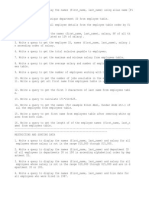0% found this document useful (0 votes)
261 views27 pagesCte Sql.
Common Table Expressions (CTEs) allow you to define temporary result sets that can be used immediately in the same query. CTEs can be used in SELECT, INSERT, UPDATE, and DELETE statements. CTEs exist only for the duration of a single query and get discarded afterwards unless defined in a view. The document provides examples of using CTEs with different SQL statements and operations like recursion.
Uploaded by
Nisha MonishaCopyright
© © All Rights Reserved
We take content rights seriously. If you suspect this is your content, claim it here.
Available Formats
Download as DOCX, PDF, TXT or read online on Scribd
0% found this document useful (0 votes)
261 views27 pagesCte Sql.
Common Table Expressions (CTEs) allow you to define temporary result sets that can be used immediately in the same query. CTEs can be used in SELECT, INSERT, UPDATE, and DELETE statements. CTEs exist only for the duration of a single query and get discarded afterwards unless defined in a view. The document provides examples of using CTEs with different SQL statements and operations like recursion.
Uploaded by
Nisha MonishaCopyright
© © All Rights Reserved
We take content rights seriously. If you suspect this is your content, claim it here.
Available Formats
Download as DOCX, PDF, TXT or read online on Scribd
/ 27





















































